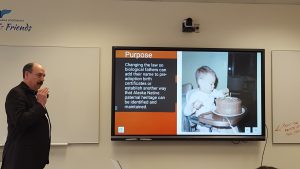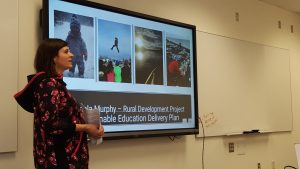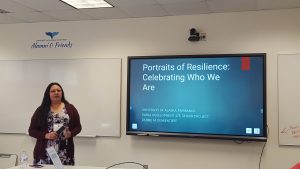DANSRD students from my class RD 475 Senior Project, Eric Petersen, Pamela Murphy, and Debbie Demientieff, presented on their senior projects at the Alaska Native Studies Conference in Juneau April 14-15. The students did a great job and got feedback and questions throughout the conference about their projects, already making a difference through their scholarship!
Eric Petersen: Alaska Native Child Adoption 
Alaska Native Child Adoption Alaska Native children have been adopted out from their biological families, communities, and cultures for decades creating generations of Alaska Natives disconnected from their cultures. While there has been significant progress made since 1978 when the Indian Child Welfare Act (ICWA) was enacted there are still issues that need to be resolved. One significant problem is that biological fathers that are not on the pre-adoption birth certificate are unable to put their name on the child’s birth certificate after the adoption is finalized. This causes a void in the child’s connection to their culture as well as impacting possible benefits from increased blood quantum. This project explores this issue and suggests possible solutions to solve the problem.
Pamela Murphy: Sustainable Education Delivery Plan
The Bristol Bay Campus faces the burning question of how to get post-secondary, relevant, education to remote locations in rural Alaska for all its 42 communities in a way that is sustainable over time. Within the Bristol Bay Region there is a high priority for quality education to prepare youth with skills to succeed in college or vocational schools. Title III funding was recently awarded to the Bristol Bay Campus to develop sustainable programs for Dillingham and its outlining service area to accomplish this vision. The purpose of this project is to establish a Sustainable Delivery Education plan, starting with the mobile welding lab pilot project. This mobile welding lab will feature covered welding stations in a shipping container and start off in the community of St. Paul, Alaska.
Debbie Demientieff: Portraits of Resilience: Celebrating Who We Are
Our traditional value of taking care of our people is essential to this project. Traditionally people have natural role models that exemplify a good way of being, a good way of living. These role models or mentors were naturally known as tribes lived close in kinship and as a community. Now, in a world where families live apart from their tribal lands and their community it is important to share the success of Alaska Native people. People who are living a good life must be uplifted and serve as a good story for others to gain their own understanding of what they themselves are capable of achieving as Alaska Native people. Today, it is important to identify these leaders and role models so that others who may never get to meet them personally are able to learn from their experiences through their stories. This project explores the use of oral history as a means of documenting and sharing Alaska Native achievement and success as a guide for others to excel and reach their own personal level of success. They will be able to look at the experiences of successful people and know that they too can make the effort to realize their own goals.
I am so proud of these students!
